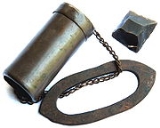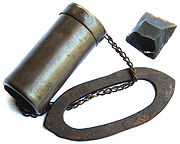
Tinderbox
Encyclopedia

Flint
Flint is a hard, sedimentary cryptocrystalline form of the mineral quartz, categorized as a variety of chert. It occurs chiefly as nodules and masses in sedimentary rocks, such as chalks and limestones. Inside the nodule, flint is usually dark grey, black, green, white, or brown in colour, and...
, firesteel
Firesteel
A Fire striker is a piece of high-carbon steel used for striking a spark, usually kept in a tinderbox together with flint and tinder.-Usage:...
, and tinder
Tinder
Tinder is easily combustible material used to ignite fires by rudimentary methods. A small fire consisting of tinder is then used to ignite kindling. Anything that can be ignited by a match can be considered tinder; or by more rigorous definition, anything that begins to glow under a shower of...
(typically charcloth
Char cloth
Char cloth is a swatch of fabric made from vegetable fiber that has been converted via pyrolysis into a slow-burning fuel of very low ignition temperature. It is capable of being ignited by a single spark that can in turn be used to ignite a tinder bundle to start a fire...
, but possibly a small quantity of dry, finely-divided fibrous matter such as straw), used together to help kindle a fire
Fire
Fire is the rapid oxidation of a material in the chemical process of combustion, releasing heat, light, and various reaction products. Slower oxidative processes like rusting or digestion are not included by this definition....
.
Tinderboxes fell out of general usage when match
Match
A match is a tool for starting a fire under controlled conditions. A typical modern match is made of a small wooden stick or stiff paper. One end is coated with a material that can be ignited by frictional heat generated by striking the match against a suitable surface...
es were invented.
Composition
In prehistoric times flintFlint
Flint is a hard, sedimentary cryptocrystalline form of the mineral quartz, categorized as a variety of chert. It occurs chiefly as nodules and masses in sedimentary rocks, such as chalks and limestones. Inside the nodule, flint is usually dark grey, black, green, white, or brown in colour, and...
and pyrites might be used, and flint and steel
Steel
Steel is an alloy that consists mostly of iron and has a carbon content between 0.2% and 2.1% by weight, depending on the grade. Carbon is the most common alloying material for iron, but various other alloying elements are used, such as manganese, chromium, vanadium, and tungsten...
from the iron age
Iron Age
The Iron Age is the archaeological period generally occurring after the Bronze Age, marked by the prevalent use of iron. The early period of the age is characterized by the widespread use of iron or steel. The adoption of such material coincided with other changes in society, including differing...
onward. Any suitably hard rock, such as quartzite
Quartzite
Quartzite is a hard metamorphic rock which was originally sandstone. Sandstone is converted into quartzite through heating and pressure usually related to tectonic compression within orogenic belts. Pure quartzite is usually white to gray, though quartzites often occur in various shades of pink...
, may be substituted for flint. The flint is chipped to provide a sharp edge suitable for striking with the steel. The firesteel is simply a piece of tempered carbon steel (as it is difficult to obtain sparks using this method with ordinary iron
Iron
Iron is a chemical element with the symbol Fe and atomic number 26. It is a metal in the first transition series. It is the most common element forming the planet Earth as a whole, forming much of Earth's outer and inner core. It is the fourth most common element in the Earth's crust...
or stainless steel
Stainless steel
In metallurgy, stainless steel, also known as inox steel or inox from French "inoxydable", is defined as a steel alloy with a minimum of 10.5 or 11% chromium content by mass....
), often formed in a "D" shape so it can be looped around two or three fingers for striking.
The charcloth
Char cloth
Char cloth is a swatch of fabric made from vegetable fiber that has been converted via pyrolysis into a slow-burning fuel of very low ignition temperature. It is capable of being ignited by a single spark that can in turn be used to ignite a tinder bundle to start a fire...
is fabric made from vegetable fibre (e.g. cotton
Cotton
Cotton is a soft, fluffy staple fiber that grows in a boll, or protective capsule, around the seeds of cotton plants of the genus Gossypium. The fiber is almost pure cellulose. The botanical purpose of cotton fiber is to aid in seed dispersal....
, linen
Linen
Linen is a textile made from the fibers of the flax plant, Linum usitatissimum. Linen is labor-intensive to manufacture, but when it is made into garments, it is valued for its exceptional coolness and freshness in hot weather....
, or jute
Jute
Jute is a long, soft, shiny vegetable fibre that can be spun into coarse, strong threads. It is produced from plants in the genus Corchorus, which has been classified in the family Tiliaceae, or more recently in Malvaceae....
) which has previously been charred via pyrolysis
Pyrolysis
Pyrolysis is a thermochemical decomposition of organic material at elevated temperatures without the participation of oxygen. It involves the simultaneous change of chemical composition and physical phase, and is irreversible...
, giving it a low ignition temperature and slow burning characteristics suitable for use as tinder. The sparks (actually pieces of burning steel broken off by the harder flint) would ignite a very small fire as they fell onto the charcloth, the glow of which could in turn be used to ignite a wood splint, after which the cloth would be extinguished for further use. With skill, a fire could be started in a few minutes. In the early 19th century a rotating metal wheel was used to create the sparks with superior results, and the wood splint might have been dipped in sulfur
Sulfur
Sulfur or sulphur is the chemical element with atomic number 16. In the periodic table it is represented by the symbol S. It is an abundant, multivalent non-metal. Under normal conditions, sulfur atoms form cyclic octatomic molecules with chemical formula S8. Elemental sulfur is a bright yellow...
(sort of a primitive nonstriking match) for better results. The sulfur tipped matches were the results of household manufacture and were sold by "matchgirls".
In the 18th century, tinderboxes were in common use.
A book from 1881 notes that in 1834 an editor had predicted that despite the advent of "lucifers" (matches), the tinder box would likely continue to be common in the household, but that in fact, by the time of writing, the tinderbox was rare, expensive, and seen commonly in museums of antiquities. A book from 1889 describes such a tinderbox, and says that the wear patterns on the flint are like those on ancient prehistoric flints in the collection.

